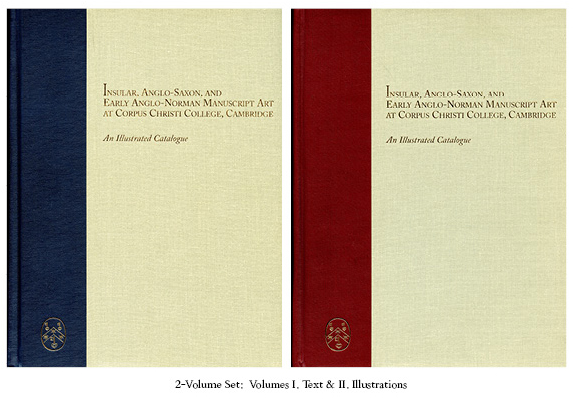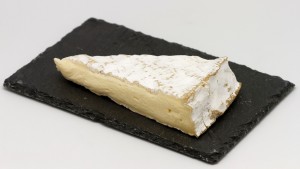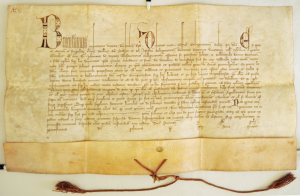Folio 4 with Latin Blessings for Holy Water and an Exorcism for Salt
June 19, 2022 in Manuscript Studies, Photographic Exhibition
Folio 4 from an ‘Italian Missal’ in Latin

Private Collection, Single Leaf from a Latin Missal. Folio 4r, Detail. Photography Mildred Budny. Reproduced by permission.
Single Leaf on Vellum
Circa 222 × 158 mm
<written area circa 150 × 104 mm>
Single columns of 18 lines,
starting below the top ruled line,
with rubricated elements
Blessings of Holy Water and Salt
and the title for an Exorcism of Salt
[qui inimici ru-/]gientis seuitiam seperas . . .
Exorcisimus ad catecuminum salis faciendum. [/]
Italy? Southern France? circa 1400–1450
Budny Handlist 10
[Posted on 20 June 2022]
We post a report of a leaf from a Private Collection which we examined and photographed a few years ago, as part of a larger study for an Illustrated Handlist.
The leaf was recorded briefly, with a description supplied by its owner, in C. U. Faye and W. H. Bond, Supplement to the Census of Medieval and Renaissance Manuscripts in the United States and Canada (1962), page 284, number 5. There it is described as part of an “Italian Missal”. The owner acquired the leaf by an unknown route, perhaps by gift already framed, before the preparation of that description for the Census.
At the owner’s request several years ago, we removed the leaf first from its plain wooden frame and then from its stained and darkened backing mat, onto which parts of the original script had offset. The leaf was photographed at several stages and examined in detail. We show views of the leaf while still on the mat and afterward.
The Leaf Before
Here are both sides of the leaf as it was mounted to the backing mat.
The Front, or Forward-Facing, Side of the Leaf as Mounted for the Frame
For the frame, the leaf faces front with lines in script in black ink and red pigment.

positioned as the front-facing page for the viewer. Private Collection. Folio 4v facing front on the former mat. Photography © Mildred Budny. Reproduced by permission.
The Other Side, Partly Lifted
Turning over the leaf, we can see the pair of hinged gauze mounting tapes which attach the edge of the leaf to the mat.

Private Collection. Folio 4r still attached to the mat with a pair of hinged gauze tapes. Photography Mildred Budny. Reproduced by permission.
The Leaf apart from the Mat
The Original Recto
The recto has a modern folio number, an upright arabic 4, entered in dark brown ink at the top right. The different expanses of the upper and lower margins imply that the short upper margin was trimmed at some stage, whilst the lower and outer margins appear to retain all or most of their original extents. The accumulated dirt along the upper edge attests to an extended duration when the former manuscript, closed, stood upright on a shelf or in storage.

Private Collection, Single Leaf from a Latin Missal. Folio 4v with Guide. Photography Mildred Budny. Reproduced by permission.
This side of the leaf shows offsets or show-through of enlarged initials at the right-hand side of the column, as well as rubricated script at points within it. The initials, in reverse, show the forms of a P and a D.
Most of these elements can be accounted for by the rubrications and the enlarged initial P on the other side of the leaf, so that they constitute show-through. For the other, we must recognize that its offset must derive from contact with a formerly adjacent leaf.
The Original Verso

Private Collection, Single Leaf from a Latin Missal. Folio 4r. Detail. Photography Mildred Budny. Reproduced by permission.
On this page, an enlarged and decorated initial P, partly inset within two indented lines of text, comprises an enlarged Capital P (for Presta) rendered in blue pigment, with penline flourishes and extensions in red pigment. In both curved and parallel straight lines, those flourishes fit between the initial and the indented letters, fill the bow and ‘footrest’ of the P, and extend in the margin above, beside, and below the initial.
A staple of the flourishing appears to be the sets of narrowly spaced parallel lines. Characteristic, too, are the short, arrowhead-tipped elements which, separately, press into the cusps of parts of the flourishing below the right-hand side of the bow of the letter and in a whorl of three around the circular extension at the upper left of the letter.
The Text
The set of texts on the leaf provide directions for Exorcisms and Blessings of Salt and Water. At an appropriate point, a sign of the cross (rendered within the outlines of a box-like frame, all in red) stands within the text to indicate its sign, or signing, as part of the ritual.
Specimens of such texts in medieval sources of various dates and from various places are edited, for example, in these bibliographical resources:
- Benedictio Salis et Aquae in the Vetera Liturgia Alemannica = J. P. Migne, Patrologia Latina, Vol. 138, cols. 1039–1052 (downloadable here).
- Missale Romanum Mediolani (1474), Vol. II = Henry Bradshaw Society, Vol. XXXIII (1907).
The text on the leaf provides snippets of the ritual for these functions. We provide a transcription, with silently expanded abbreviations, and with indications of the rubrications in red.
Recto
[Oratio . . . qui inimici ru-/]
gientis scuitiam superas. qui ho-
stiles nequitias potens expu-
gnas. te domine trementes et sup-
plices deprecam; ac petitumus. ut
hanc creaturam salis et aque di-
gnanter accipias. benignus il-
lustres. pietatis tue more san-
ctifices. + At ubi cumque sue-
nt aspersa per in uocationes sancti
tui nominis omis infestatio in
mundi spiritus abieiatur. terrorque . +
uenenosi serpentis procul pellatur.
et presentia sancti spiritus nobis misericordiam
tuam poscentibus ubique adesse di-
gnitur. Per dominum nostrum in uinitate +
eiusdem spiritus sancti deus per omnia secula
seculorum. Alia oratio
Presta domine tuum saltare reme-
Verso
dium super hand creaturam salis et
aque. Ut ubicumque interserit. ad
anime et corporis proficiat sani-
tatem. Per dominum. Alia oratio qui dicitur
i[n] fine benedictionis aque.
Presta quos domine deus super hanc creatu-
ram aspersionis aque sanitatem
mentis integritatem corpus : tu-
telam saltis. securitatem spei. cor-
roborationem fidei hic et in eter-
num in secula seculorum. Amen. Sequitur.
Dominus vobiscum. Responsio. Et cum spiritu tuo.
kyrie. kyrie. kyrie. item. Benedicat et exaudi-
at nos deus. Responsio. Amen. iter. Procedamus
cum pace. Responsio. Innomine [sic, for In nomine] christi. item. Bene-
dicamus domino. Responsio. Deo gratias. Exorci-
simus at catecuminum salis facien-
dum.
The Former Manuscript
Parts of the text, or some texts in the sequence, can be found in other sources. For example, comparisons for the text of the Roman Missal for the Liturgical Use of Milan (printed in 1474), show a similar version of the Presta which appears on the verso, although its version begins somewhat differently.
Presta michi domine deus per hanc creaturam aspersionis aque atque sanitatem mentis integritatem corpus : tutelam saltis : securitatem spei. corroborationem fidei : fructum charitatis nune et in futuro. Amen.
- See Robert Lippe, Missale Romanum Mediolani (1474), Vol. II: A Collation with other Editions Printed before 1570. Henry Bradshaw Society, Vol. XXXIII (1907), at page 385.
The Milan Missal of 1474 was printed at Venice by Antonius Zarotis, with the date of 6 December 1474 (Incunabula Shorttitle Catalogue Number im00688450).
The long prayer on the recto belongs to the blessing of water.
It begins with an exorcism (or purification) of salt — but not the one intended for catechumens. as specified in the rubricated title at the bottom on the verso of the leaf.
Both the long prayer on the recto and the two following prayers also occur in that order in the Sacramentary portion of the composite Leofric Missal, but not followed by the exorcism of salt.
- Frederick Edward Warren, ed., The Leofric Missal, As Used in the Cathedral of Exeter During the Episcopate of Its First Bishop, A.D. 1050-1072, Together with Some Account of the Red Book of Derby, the Missal of Robert of Jumieges, and a Few Other Early Manuscript Service Books of the English Church (Oxford: Clarendon Press, 1883, page 250.
There is a close match for the sequence of texts on the leaf, with only a few variations, in an another source from Milan later than the printed edition of 1474. That is:
- the Rituale Sacramentorum ad Usum Mediolanensis Ecclesiae (“Ritual of the Sacraments for the Use of the Church of Milan“) of 1815, at pages 282–283.
The text on the Recto of the leaf starts on page 282 in the Oratio: “[inimici ru-/]gientis saevitiam superas . . .” The Oratio begins thus: Deus invictae virtutis Auctor . . . A brief section of text intervenes between this opening and the top of the extant recto. Such an initial D, low in the column, formed the offset at the right-hand side of the column on the recto.
The “Alia Oratio Presta domine tuum salutare . . .” ends the recto and continues on the verso into the Aquam Benedictam “Presta quaesumus domine.” Then come the Versicles and Responses extending to “Deo gratias”, but not the “Pax . . .”
Since the following text following refers to “hanc creaturam salis”, it may be the exorcism for which we have only the title.
The correspondences with texts in Missals associated with Milan, in northern Italy, might strengthen, but not confirm, the suggested origin of the leaf as part of an “Italian Missal” — or some similar liturgical handbook — in Latin from such a region.
For now, pending further information (such as the discovery of more parts of the same manuscript), let us continue to refer to it as containing (or, by virtue of the title, implying) a set of Ordines which address 1) the Blessing for the preparation of Holy Water and Salt, and 2) the Exorcism (or Purification) of Salt for Catechumens. The former has a place in the Sacramentary portion of a Missal, whereas the latter would pertain, insofar as we have been able to discover, to a different form of book instead — such as a Collectar.
The folio number 4 indicates that the leaf occupied an early position within its book, whether or not that modern numeration took into account leaves (such as endleaves) which a modern observer might deem extraneous. As companion materials, the texts to which this leaf belonged could have formed prefatory matter for a book of one or other genre designed to guide instruction and performance of liturgical practices at whatever stages required for the place of its production.
Perhaps other leaves from the same book as well as further research will resolve the mystery. This lone leaf joins the company of all too many single, dispersed, leaves which have lost track or trace (apart from, say, an offset from an adjacent leaf) of their former siblings. By close inspection of their material and textual evidence, it can partly become possible to retrieve some elements of their former connections and contexts.
Welcome to the ‘Foundling Hospital for Manuscript Fragments’, as invited in one of the early posts for our blog.
*****
Do you know of more leaves from this manuscript? Do you recognize the hand of the scribe, scribal artist, and rubricator in other parts of this book or in other manuscripts?
You might reach us via Contact Us or our Facebook Page. Comments here are welcome too. We look forward to hearing from you.
Watch our blog on Manuscript Studies for more discoveries. Please visit its Contents List.
*****

Private Collection, Single Leaf from a Latin Missal. Folio 4r, Detail. Reproduced by permission.
*****

 Otto Ege’s
Otto Ege’s Continuing our series of interviews and reports, we explore the processes by which Mildred Budny’s 2-volume Insular, Angl0-Saxon, and Early Anglo-Norman Manuscript Art at Corpus Christi College, Cambridge: An Illustrated Catalogue (“The Catalogue” or “The Illustrated Catalogue”) was designed, laid out, and typeset to camera-ready copy for its publication as a set of 2 volumes of “Text” and “Plates”.
Continuing our series of interviews and reports, we explore the processes by which Mildred Budny’s 2-volume Insular, Angl0-Saxon, and Early Anglo-Norman Manuscript Art at Corpus Christi College, Cambridge: An Illustrated Catalogue (“The Catalogue” or “The Illustrated Catalogue”) was designed, laid out, and typeset to camera-ready copy for its publication as a set of 2 volumes of “Text” and “Plates”.




















A Leaf from Gregory’s Dialogues Reused for Euthymius
December 24, 2016 in Manuscript Studies, Photographic Exhibition, Uncategorized
A Leaf from Gregory’s Dialogues
Reused for Binding
A Copy of
Euthymius Zigabenus’s On the Psalms
Budny Handlist 3
In our blog on Manuscript Studies (see its Contents List), Mildred Budny (see Her Page) continues to report the results of research for her Illustrated Handlist.
Here, we focus upon a leaf plucked from its 12th-century manuscript and pressed into service, with trimmed edges and mitered folds, as the vellum covering for a binding for a different text of small format. Both texts, primary and secondary in the life of the leaf, concern religious subjects, but they emanate from authors of different dates, locations, and languages in the Latin West and the Orthodox East respectively. The primary text represents a remnant of a text and an author familiar in some other blogposts, which consider the Dialogues, the Sermons or Homilies, and other texts by Pope Gregory the Great (pope from 590 to 694 CE).
Handlist 3, Recto
Handlist 3, Verso
Part of Gregory’s Dialogues, Book III, Chapter 7
(on Andreas, Bishop of Fondi/Fundi):
Sections 2 (Hic namque uenerabilis uir) –
8 (uel quae in conuentu)
Present measurements:
Circa 357 × 237 mm
< written area circa 266 × 133 mm >
Single column of 28 lines
in revived Caroline minuscule
without embellishments
Germany, circa 1175
Reused for some time as the vellum cover for the binding of a copy of
Euthymius Zigabenus‘s Commentary on the Psalms
in Greek or in Latin translation?
(now lost or preserved elsewhere in a location unknown)
For this secondary use, the remnants of a set of titles on the outside of the spine of the cover (the original verso of the reused leaf) remain in place, albeit abraded and fragmented, as both a pasted, inscribed paper label (orientated along the ‘horizontal’ across the spine) and an ink inscription on the reused leaf itself in Capitals (‘vertical’, with the tops of those letters turned toward the ‘front cover’). Another, smaller and fragmentary pasted label with a broad rectangular border stands near the bottom of the broad spine of the cover and partly overlies the ‘vertical’ spine inscription.
Acquired, probably by purchase (according to the Owner’s recollections), in France in the past 15 years or so, but before 2007 when I first saw and began to photograph the leaf. This item and others in the Illustrated Handlist acquired in France at various times and by various means (purchase, gift, or exchange), came from a single source in the Département of Saône-et-Loire, from about 1999 onward. Because the leaf does not carry indications of its original place and time of production, apart from its materials, layout, design, script, orthography, and punctuation, those unknowns must depend upon evaluations of the style of the script, lacking any forms of embellishment, such as decorated initials, which might have provided possibly more closely datable symptoms than the letters “alone”.
Read the rest of this entry →
Tags: 'Fifty Original Leaves from Medieval Manuscripts', Binding History, Bishop Andrew of Fundi, Budny's Illustrated Catalogue, Ege Manuscript 41, Euthymius Zigabenos, Fondi, Gregory the Great, Gregory's Dialogues, manuscript fragments, Manuscript Fragments Reused in Bindings, Manuscript studies, Psalter Commentary, Saki, Temple of Apollo
No Comments »